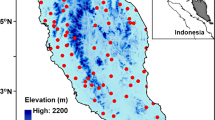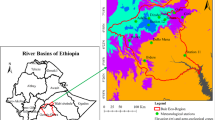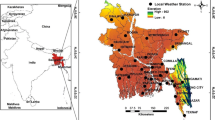Abstract
In this study, performances of forty-one Global Climate Models (GCMs) from the data archive of Coupled Model Intercomparison Project Phase 6 (CMIP6) were evaluated in simulating the Southwest Monsoon Rainfall (SWMR) for the historical run from 1955 to 2014 over the Indian Monsoon Core Region (MCR) using gridded rainfall data available at daily scale from the India Meteorological Department (IMD). An evaluation framework based on statistical metrics and skill scores were adopted for assessment, and a Comprehensive Rating Index (CRI) was estimated for ranking the models. The systematic analysis showed that 51% of models performed well in the MCR of India for the study period taken. Later, the future possible precipitation variability in terms of intensity and frequency for the top-ranked model, NorESM2-MM, was analysed using a Probability Density Function (PDF) method in three categories of monsoon years, namely strong, weak, and normal. The analysis was done under four Shared Socioeconomic Pathway (SSP) scenarios, with the radiative forcing of 2.6, 4.5, 7.0, and 8.5 (W/m2) during near (2021–2040), mid (2041–2060), and long (2081–2100) term future projection periods. On the seasonal scale, it is speculated that the intensity of monsoon precipitation distribution may increase progressively up to 20 mm/day for strong and normal SWMR years by the end of the twenty-first century. The projected precipitation mean change during strong and normal SWMR years were calculated to increase up to ~ 27% and ~ 21%, and for weak SWMR, it was ~ 49%, the highest among the other two categories. The projected results confirm and indicate the strong sensitivity of regional monsoon to the increasing greenhouse gas emissions and land use change.














Similar content being viewed by others
Data availability
IMD rainfall gridded data is available at https://www.imdpune.gov.in/cmpg/Griddata/Rainfall_25_NetCDF.html (Pai et al. 2014). CMIP6 data used in this study is available at https://esgf-node.llnl.gov/search/cmip6/.
References
Almazroui M, Saeed F, Saeed S, Ismail M, Ehsan MA, Islam MN ... Nadeem I (2021) Projected changes in climate extremes using CMIP6 simulations over SREX regions. Earth Syst Environ, 5(3), 481–497
Bhaskaran B, Mitchell JFB, Lavery JR, Lal M (1995) Climatic response of the Indian subcontinent to doubled CO2 concentrations. Int J Climatol 15(8):873–892
Cherchi A, Alessandri A, Masina S, Navarra A (2011) Effects of increased CO 2 levels on monsoons. Clim Dyn 37:83–101
Eyring V, Bony S, Meehl GA, Senior CA, Stevens B, Stouffer RJ, Taylor KE (2016) Overview of the Coupled Model Intercomparison Project Phase 6 (CMIP6) experimental design and organization. Geo Model Dev 9(5):1937–1958
Friedlingstein P, Meinshausen M, Arora VK, Jones CD, Anav A, Liddicoat SK, Knutti R (2014) Uncertainties in CMIP5 climate projections due to carbon cycle feedbacks. J Clim 27(2):511–526
Gadgil S, Yadumani, Joshi (1993) Coherent rainfall zones of the Indian region. Intl J Climatol, 13(5), 547-566
Goswami BN, Venugopal V, Sengupta D, Madhusoodanan MS, Xavier PK (2006) Increasing trend of extreme rain events over India in a warming environment. Science 314(5804):1442–1445
Gupta V, Singh V, Jain MK (2020) Assessment of precipitation extremes in India during the 21st century under SSP1–1.9 mitigation scenarios of CMIP6 GCMs. J Hydrol, 590, 125422
Gusain A, Ghosh S, Karmakar S (2020) Added value of CMIP6 over CMIP5 models in simulating Indian summer monsoon rainfall. Atmos Res 232:104680
Hu ZZ, Latif M, Roeckner E, Bengtsson L (2000) Intensified Asian summer monsoon and its variability in a coupled model forced by increasing greenhouse gas concentrations. Geophys Res Lett 27(17):2681–2684
Hsu PC, Li T, Luo JJ, Murakami H, Kitoh A, Zhao M (2012) Increase of global monsoon area and precipitation under global warming: a robust signal?. Geophys Res Lett, 39(6)
IPCC (2007) Climate change 2007 – The physical science basis contribution of working group I to the fourth assessment report of the IPCC
IPCC (2021) Climate change 2022: impacts, adaptation and vulnerability. In: Pörtner, H.-O., Roberts, D.C., Tignor, M., Poloczanska, E.S., Mintenbeck, K., Alegría, A. et al. (Eds.) Contribution of Working Group II to the Sixth Assessment Report of the Intergovernmental Panel on Climate Change. Cambridge: Cambridge University Press, pp. 37–118. https://doi.org/10.1017/9781009325844.002
Iyengar RN, Basak P (1994) Regionalization of Indian monsoon rainfall and long-term variability signals. Int J Climatol 14:1095–1114
Jiang Z, Li W, Xu J, Li L (2015) Extreme precipitation indices over China in CMIP5 models. Part I: Model evaluation. J Climate, 28(21), 8603–8619
Kitoh A, Yukimoto S, Noda A, Motoi T (1997) Simulated changes in the Asian summer monsoon at times of increased atmospheric CO2. J Meteorol Soc Japan. Ser. II, 75(6), 1019–1031
Kitoh A, Endo H, Krishna Kumar K, Cavalcanti IF, Goswami P, Zhou T (2013) Monsoons in a changing world: A regional perspective in a global context. J Geophys Res: Atmospheres 118(8):3053–3065
Kripalani RH, Oh JH, Kulkarni A, Sabade SS, Chaudhari HS (2007) South Asian summer monsoon precipitation variability: coupled climate model simulations and projections under IPCC AR4. Theoret Appl Climatol 90:133–159
Krishna Kumar K, Patwardhan SK, Kulkarni A, Kamala K, Rao KK, Jones R (2011) Simulated projections for summer monsoon climate over India by a high-resolution regional climate model (PRECIS). Curr Sci 101(3):312–326
Mann, H.B. (1945) Nonparametric tests against trend. Econometrica: Journal of the Econometric Society, 13, 245–259.
Mooley DA, Parthasarathy B (1984) Fluctuations in all-India summer monsoon rainfall during 1871–1978. Clim Change 6(3):287–301
O'Neill BC, Tebaldi C, Van Vuuren DP, Eyring V, Friedlingstein P, Hurtt G ... Sanderson BM (2016) The scenario model intercomparison project (ScenarioMIP) for CMIP6. Geosci Model Dev, 9(9), 3461–3482
Pai DS, Rajeevan M, Sreejith OP, Mukhopadhyay B, Satbha NS (2014) Development of a new high spatial resolution (0.25× 0.25) long period (1901–2010) daily gridded rainfall data set over India and its comparison with existing data sets over the region. Mausam, 65(1), 1–18
Perkins SE, Pitman AJ, Holbrook NJ, McAneney J (2007) Evaluation of the AR4 climate models’ simulated daily maximum temperature, minimum temperature, and precipitation over Australia using probability density functions. J Clim 20(17):4356–4376
Ramesh KV, Goswami P (2007) Reduction in temporal and spatial extent of the Indian summer monsoon. Geophys Res Lett, 34(23)
Rajeevan M, Bhate J, Jaswal AK (2008) Analysis of variability and trends of extreme rainfall events over India using 104 years of gridded daily rainfall data. Geophys Res Lett, 35(18)
Rajeevan M, Gadgil S, Bhate J (2010) Active and break spells of the Indian summer monsoon. J Earth Syst Sci 119:229–247
Rao YP (1976) Southwest monsoon. Meteorological Monograph: Synoptic Meteorology number: 1/1976
Rajesh PV, Goswami BN, Choudhury BA, Zahan Y (2021) Large sensitivity of simulated Indian summer monsoon rainfall (ISMR) to global warming: implications of ISMR projections. J Geophys Res: Atmospheres, 126(1), e2020JD033511
Riahi K, Van Vuuren DP, Kriegler E, Edmonds J, O’neill B C, Fujimori S ... Tavoni M (2017) The Shared Socioeconomic Pathways and their energy, land use, and greenhouse gas emissions implications: An overview. Global Environ Change, 42, 153-168
Rivera JA, Arnould G (2020) Evaluation of the ability of CMIP6 models to simulate precipitation over Southwestern South America: Climatic features and long-term trends (1901–2014). Atmos Res 241:104953
Saha A, Ghosh S, Sahana AS, Rao EP (2014) Failure of CMIP5 climate models in simulating post-1950 decreasing trend of Indian monsoon. Geophys Res Lett 41(20):7323–7330
Sarkar S, Maity R (2022) Future Characteristics of Extreme Precipitation Indicate the Dominance of Frequency Over Intensity: A Multi‐Model Assessment From CMIP6 Across India. J Geophys Res: Atmospheres, 127(16), e2021JD035539
Sen PK (1968) Estimates of the regression coefficient based on Kendall’s tau. J Am Stat Assoc 63(324):1379–1389
Sharmila S, Joseph S, Sahai AK, Abhilash S, Chattopadhyay R (2015) Future projection of Indian summer monsoon variability under climate change scenario: An assessment from CMIP5 climate models. Global Planet Change 124:62–78
Shepard D (1968) A two-dimensional interpolation function for irregularly-spaced data. In Proceedings of the 1968 23rd ACM national conference (pp. 517–524)
Sooraj KP, Terray P, Xavier P (2016) Sub-seasonal behaviour of Asian summer monsoon under a changing climate: assessments using CMIP5 models. Clim Dyn 46:4003–4025
Taylor KE (2001) Summarizing multiple aspects of model performance in a single diagram. Journal of Geophysical Research: Atmospheres 106(D7):7183–7192
Turner AG, Annamalai H (2012) Climate change and the South Asian summer monsoon. Nat Clim Chang 2(8):587–595
Wang B, Yim SY, Lee JY, Liu J, Ha KJ (2014) Future change of Asian-Australian monsoon under RCP 4.5 anthropogenic warming scenario. Clim Dyn 42:83–100
Webster PJ, Magana VO, Palmer TN, Shukla J, Tomas RA, Yanai MU, Yasunari T (1998) Monsoons: Processes, predictability, and the prospects for prediction. J Geophys Res: Oceans 103(C7):14451–14510
Yang X, Zhou B, Xu Y, Han Z (2021) CMIP6 evaluation and projection of temperature and precipitation over China. Adv Atmos Sci 38:817–830
Zheng Y, Bourassa MA, Ali MM, Krishnamurti TN (2016) Distinctive features of rainfall over the Indian homogeneous rainfall regions between strong and weak Indian summer monsoons. J Geophys Res: Atmospheres 121(10):5631–5647
Zhou T, Chen X, Wu B, Guo Z, Sun Y, Zou L ... He C (2017) A robustness analysis of CMIP5 models over the East Asia-Western North Pacific domain. Engineering, 3(5), 773–778
Acknowledgements
We acknowledge the India Meteorological Department (IMD) for providing gridded rainfall datasets; and Earth System Grid Federation (ESGF) – for providing GCM precipitation datasets. Also, We would like to acknowledge the Department of Physics and Nanotechnology at SRM Institute of Science and Technology, Kattankulathur, for supporting us in carrying out this work.
Funding
The authors declare that no funds, grants, or other support were received during the preparation of this manuscript.
Author information
Authors and Affiliations
Contributions
T. Kesavavarthini – Formal Analysis, Data Curation, Writing-Original draft, A. Sabarinath – Data Curation, Meera M. Nair – Data Curation, A. Naga Rajesh – Conceptualization, Methodology, Validation, Investigation, Writing-Review and Editing, Supervision.
Corresponding author
Ethics declarations
Competing interests
The authors declare no competing interests.
Additional information
Publisher's Note
Springer Nature remains neutral with regard to jurisdictional claims in published maps and institutional affiliations.
Supplementary Information
Below is the link to the electronic supplementary material.
Rights and permissions
Springer Nature or its licensor (e.g. a society or other partner) holds exclusive rights to this article under a publishing agreement with the author(s) or other rightsholder(s); author self-archiving of the accepted manuscript version of this article is solely governed by the terms of such publishing agreement and applicable law.
About this article
Cite this article
Kesavavarthini, T., Sabarinath, A., Nair, M.M. et al. Assessment of CMIP6 GCMs’ Simulation of Southwest Monsoon Rainfall over Indian Monsoon Core Region. Theor Appl Climatol (2024). https://doi.org/10.1007/s00704-024-04974-y
Received:
Accepted:
Published:
DOI: https://doi.org/10.1007/s00704-024-04974-y




